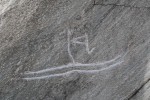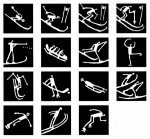 An iconic prehistoric carving of a person on skis has been irreparably damaged by two dumb kids who took a sharp object to it. The skier, part of a larger design known as Valentine Field which depicts a Stone Age hunting scene, was carved about 5,000 years ago on a rock face on the island of Tro off the coast of Nordland, northern
An iconic prehistoric carving of a person on skis has been irreparably damaged by two dumb kids who took a sharp object to it. The skier, part of a larger design known as Valentine Field which depicts a Stone Age hunting scene, was carved about 5,000 years ago on a rock face on the island of Tro off the coast of Nordland, northern  Norway. The carvings have weathered over the millennia, making them hard to see on the dry rock. The vandals thought they could fix that problem by scratching out the lines with a sharp stone or similar object. Then they did the same to the figure of a whale that is also part of Valentine Field.
Norway. The carvings have weathered over the millennia, making them hard to see on the dry rock. The vandals thought they could fix that problem by scratching out the lines with a sharp stone or similar object. Then they did the same to the figure of a whale that is also part of Valentine Field.
The vandalism was reported by one of the residents of a summer home on the island to Tor-Kristian Storvik, the Nordland County archaeologist, who immediately went to assess the damage. What he found was tragic.
“It’s a sad, sad story,” he said. “The new lines are both in and outside where the old marks had been. We will never again be able to experience these carvings again the way we have for the last 5,000 years.”
Experts will return to the site in September to study the skier and whale in depth and determine what, if anything, can be done to repair the damage, but as of now, there is little cause for optimism. The petroglyph appears to be irretrievably altered.
When the story broke, it made national and international news. The perpetrators, apparently chastened by the outraged reaction to their recklessness, confessed. They claim their intentions were good — to make the carvings more legible — and didn’t realize they were violating the law and every basic principle of how to interact with ancient and precious things. Their names and ages have not been released to the public.
Storvik has filed a police report on the vandalism and the boys could be criminally prosecuted as a violation of the Cultural Heritage Act, but no legal action has been taken as of yet. Bård Anders Langø, the mayor of Alstahaug, is discussing with county authorities how best to proceed. Apparently the boys are very young and remorseful, so it doesn’t seem likely at this point that they’ll have the book thrown at them. Last week they relayed an apology in a statement from the Alstahaug municipality.
 The image of the skier was the inspiration for the set of pictograms illustrating the sports of the 1994 Winter Olympics in Lillehammer. Each host city creates their own pictograms to identify events and venues by sport with an easily recognizable image. Mostly they look like very active versions of the signs on bathroom doors, but Lillehammer embraced its ancient heritage of winter sports and artist Sarah Rosenbaum created luges, hockey players and skaters that could easily have been carved on rock faces 5,000 years ago.
The image of the skier was the inspiration for the set of pictograms illustrating the sports of the 1994 Winter Olympics in Lillehammer. Each host city creates their own pictograms to identify events and venues by sport with an easily recognizable image. Mostly they look like very active versions of the signs on bathroom doors, but Lillehammer embraced its ancient heritage of winter sports and artist Sarah Rosenbaum created luges, hockey players and skaters that could easily have been carved on rock faces 5,000 years ago.
If these carvings were so important, why were they not protected from public access? Authorities in control of cultural heritage sites have the responsibility to provide reasonable controls to prevent such damage. Was not even a sign present? Lesson learned: What other culturally significant sites are vulnerable to such “good intentioned” but uninformed people? Do they need protecton? It is time to face the realities of the modern world.
Why not force the kids to become archaeologists…
Don’t get me wrong: This is a clear case of vandalism -I hope the Vandals wont be offended- that I am not going to vindicate. Before that piece of rock art was created, however, the surface here seems to have been cleared by a glacier, and in a few millennia from now, there will have been another glacier and -as far as I can tell from here- another rock artist.
The damage could possibly have been worse, and the weather will certainly do its job (Ok, the damage -is- in fact pretty bad). Contrastingly, rock art is -from what I’ve heard- sometimes made visible with colored powder, and even the ancient rock artists might have used some form of ochre back then: Kids, ask FIRST before you do anything harmful !
Well, if what I can find is correct, the petroglyphs are located on a 3.3 square mile island off the coast of Norway, a bit over a degree south of the Arctic Circle. The whole “municipality” the island is part of has a population of about 1,300. So, the glyphs are fairly remote. Probably no one dreamed that anyone who could get to the glyphs would be dumb enough to do something to them.
A cynic would wonder whether the boys muttered “Allahu Akbar” as they did it.
The endless self-censorship of the media is bound to promote such suspicions, whether accurate or inaccurate.
In this case, my money is on the cynic being wrong, even though he’s so often right.
M
O
N
E
Y
The ever odd Barry Fell once made some great pronouncements about some glyphs near my childhood home. What Barry didn’t know was that most of the glyphs had been altered over the years by later Native Americans and Anglo locals who had used the rock shelter as a place to camp for centuries while hunting, or with the latter, making whiskey and hunting.
So much for those Ogham translations Barry deciphered from lost Irish monks wandering around the backwoods of Appalachia in the 6th century. Likely the marks were where someone sharpened their knives before butchering a deer or a bear.
“lost Irish monks”: these chaps should be an easy target for archaeologists, since their boats were made of stone. Allegedly.
Mind you, have you seen this?
http://www.independent.co.uk/news/science/denmark-s-historic-claim-to-the-faroes-in-doubt-as-archaeologists-find-proof-that-islands-were-8776954.html
Hanc oram novissimi maris tunc primum Romana classis circumvecta insulam esse Britanniam adfirmavit, ac simul incognitas ad id tempus insulas, quas Orcadas vocant, invenit domuitque. Dispecta est et Thule, quia hactenus iussum, et hiems adpetebat.
Around these coasts of the remotest ocean sailed a Roman fleet for the first time, proving that Britain is an island, and simultaneously discovered and conquered what are called the Orcades, islands hitherto unknown. Thule too was descried in the distance, which as yet had been hidden by the snows of winter.
Eadem aestate cohors Usiporum per Germanias conscripta et in Britanniam transmissa magnum ac memorabile facinus ausa est. Occiso centurione ac militibus, qui ad tradendam disciplinam inmixti manipulis exemplum et rectores habebantur, tris liburnicas adactis per vim gubernatoribus ascendere; et uno remigante, suspectis duobus eoque interfectis, nondum vulgato rumore ut miraculum praevehebantur. Mox ad aquam atque utilia raptum [ubi adpul]issent, cum plerisque Britannorum sua defensantium proelio congressi ac saepe victores, aliquando pulsi, eo ad extremum inopiae venere, ut infirmissimos suorum, mox sorte ductos vescerentur. Atque ita circumvecti Britanniam, amissis per inscitiam regendi navibus, pro praedonibus habiti, primum a Suebis, mox a Frisiis intercepti sunt.
The same summer a Usipian cohort, which had been levied in Germany and transported into Britain, ventured on a great and memorable exploit. Having killed a centurion and some soldiers, who, to impart military discipline, had been incorporated with their ranks and were employed at once to instruct and command them, they embarked on board three swift galleys with pilots pressed into their service. Under the direction of one of them—for two of the three they suspected and consequently put to death -they sailed past the coast in the strangest way before any rumor about them was in circulation. After a while, dispersing in search of water and provisions, they encountered many of the Britons, who sought to defend their property. Often victorious though now and then beaten, they were at last reduced to such an extremity of want as to be compelled to eat, at first, the feeblest of their number, and then victims selected by lot. Having sailed round Britain and lost their vessels from not knowing how to manage them, they were looked upon as pirates and were intercepted, first by the Suevi and then by the Frisii.
————
S: Tacitus’ “Agricola” in ~98 AD, chapters X and XXVIII – “Existence of sea-faring northern Europeans before Vikings” ?!? The Orkney’s were inhabited for ..since.. forever :confused:
The prehistoric carving of a person on skis is misinterpreted, it is a man on a boat. People think it is skis because there is a lot of snow there now.
They need to quite literally look at the big picture.
Barry included Phoenicians, Libyans, Carthaginians, Tartessians, and others in his groups of people he personally discovered evidence of up and down the eastern half of N. America.
Of course, many of them wrote in languages that were deciphered, in America, by guess who? Barry Fell. Often with no Old World antecedents whatsoever. The things that man could do! Gavin Menzies has a long way to go to catch Barry.
As for stone boats, dearieme, that’s no problem. You slide them on the back of the whales St. Brendan tamed and away you go. Easy peasy.
With the Faroe’s, this latest discovery’s time frame seems to align with the early Dal Riada expansion out of N. Ireland and into the Western Isles. Perhaps they followed the North Atlantic drift a little further along than rest of their relatives? There’s a lot of research to be done on what was going on the Faroes in that time period.
My guess is monks: when the Vikings discovered Iceland they commented on the monks who were already there, at least if the eventual writing down of their oral history is to be believed. I’ve no idea whether there’s any archaeological evidence.
What a fuss. By definition, kids are dumb. Comes with the territory. Lucky we are if we managed to make it to adulthood without making dumb mistakes. Now we have to decide if what they did in well-meaning ignorance was really vandalism and worthy of the kind of punishment meant for people who are intentionally destructive or removing artifacts for gain. It really doesn’t sound as if it were either of those things. I like the suggestions about getting them involved in archaeology. Learning to reconstruct or preserve ancient artifacts under guidance sounds like a way of making restitution as well as acknowledging what appears to be a spark of interest in the ancient world. I hope that someday an interview of a well-respected archaeologist includes a sheepish story about how he/she got involved in the field.
Kill em
Force them to become monks.
The kids were merely trying to remove the glyphs so that they could store them for a few decades in their Swiss warehouse.